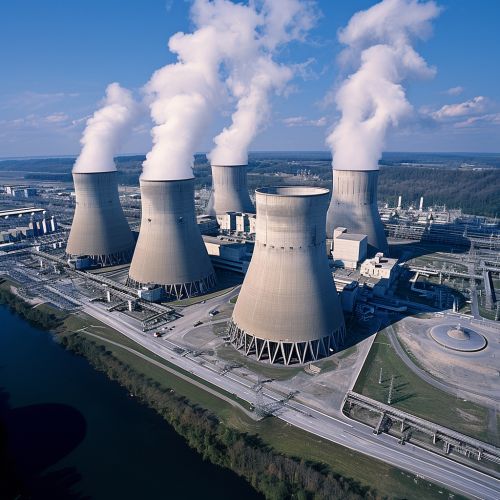Nuclear power plants
Introduction
Nuclear power plants are facilities that generate electricity through a process known as nuclear fission. This process involves the splitting of atomic nuclei, which releases a significant amount of energy. These plants are a major source of base load power, providing a steady and reliable supply of electricity.

Operation of Nuclear Power Plants
Nuclear power plants operate by using the heat generated from nuclear fission to produce steam, which then drives a turbine connected to an electric generator. The process begins in the reactor core, where uranium or plutonium fuel rods are bombarded with neutrons, causing the atomic nuclei to split and release energy in the form of heat.
Reactor Core
The reactor core is the heart of a nuclear power plant. It contains the nuclear fuel, control rods, and the coolant. The nuclear fuel is typically uranium or plutonium, which undergoes fission when struck by a neutron. The control rods are made of materials that absorb neutrons, such as boron or cadmium. They are used to regulate the rate of fission and, thus, the amount of heat produced.
Cooling System
The cooling system plays a crucial role in the operation of a nuclear power plant. It removes the heat generated in the reactor core and uses it to produce steam. The coolant, usually water, is circulated through the reactor core where it absorbs the heat produced by the fission process. This heated water is then transferred to a steam generator, where it heats a separate water supply to produce steam.
Turbine and Generator
The steam produced in the steam generator is used to drive a turbine. The turbine is connected to an electric generator, which converts the mechanical energy of the spinning turbine into electrical energy. After passing through the turbine, the steam is condensed back into water and returned to the steam generator, completing the cycle.
Types of Nuclear Power Plants
There are several types of nuclear power plants, categorized based on the type of reactor used. The most common types are pressurized water reactors (PWRs), boiling water reactors (BWRs), and heavy water reactors (HWRs).
Pressurized Water Reactors
Pressurized water reactors are the most common type of nuclear power plant. In a PWR, the water used as a coolant is kept under high pressure to prevent it from boiling. This pressurized water is circulated through the reactor core, absorbing the heat produced by the fission process. The heated water then transfers its heat to a secondary water supply in a steam generator, which produces the steam used to drive the turbine.
Boiling Water Reactors
In a boiling water reactor, the water used as a coolant is allowed to boil directly in the reactor core. The steam produced is then used to drive the turbine. Because the steam comes into direct contact with the reactor core, it is radioactive and must be contained within the reactor building.
Heavy Water Reactors
Heavy water reactors use heavy water, or deuterium oxide, as a coolant and neutron moderator. This type of reactor can use natural uranium as fuel, unlike PWRs and BWRs, which require enriched uranium.
Safety Measures in Nuclear Power Plants
Nuclear power plants are designed with multiple safety systems to prevent accidents and mitigate their effects if they do occur. These include containment structures, emergency cooling systems, and radiation monitoring systems.
Containment Structures
The containment structure is a robust building designed to prevent the release of radioactive materials in the event of an accident. It houses the reactor and the primary coolant system. The structure is designed to withstand extreme conditions, including high pressure, temperature, and radiation levels.
Emergency Cooling Systems
Emergency cooling systems are designed to remove heat from the reactor core in the event of a loss of coolant accident. These systems use a variety of methods to cool the reactor, including the injection of water or other coolants, and the use of passive cooling systems that operate without the need for external power.
Radiation Monitoring Systems
Radiation monitoring systems are used to detect and measure radiation levels in and around the nuclear power plant. These systems provide early warning of any increase in radiation levels, allowing for prompt action to protect workers and the public.
Environmental Impact of Nuclear Power Plants
While nuclear power plants produce no direct carbon emissions, they do have an environmental impact. This includes the production of radioactive waste, the potential for accidents, and the impact of uranium mining.
Radioactive Waste
One of the major environmental concerns associated with nuclear power plants is the production of radioactive waste. This waste is highly radioactive and must be carefully managed and stored for thousands of years to prevent it from harming people or the environment.
Potential for Accidents
While nuclear power plants are designed with multiple safety systems, there is always the potential for accidents. The most notable nuclear accidents are the Chernobyl disaster in 1986 and the Fukushima Daiichi nuclear disaster in 2011. These accidents resulted in significant releases of radioactive materials and had severe environmental and health impacts.
Uranium Mining
The mining of uranium, the primary fuel for nuclear power plants, also has an environmental impact. Uranium mining can result in the release of radioactive dust and radon gas, and the production of large amounts of waste rock and tailings.
Future of Nuclear Power
The future of nuclear power is a subject of ongoing debate. While nuclear power provides a significant portion of the world's electricity and produces no direct carbon emissions, concerns about safety, waste disposal, and the potential for weapon proliferation remain. New technologies, such as small modular reactors and Generation IV reactors, offer the potential for safer, more efficient, and less wasteful nuclear power.
